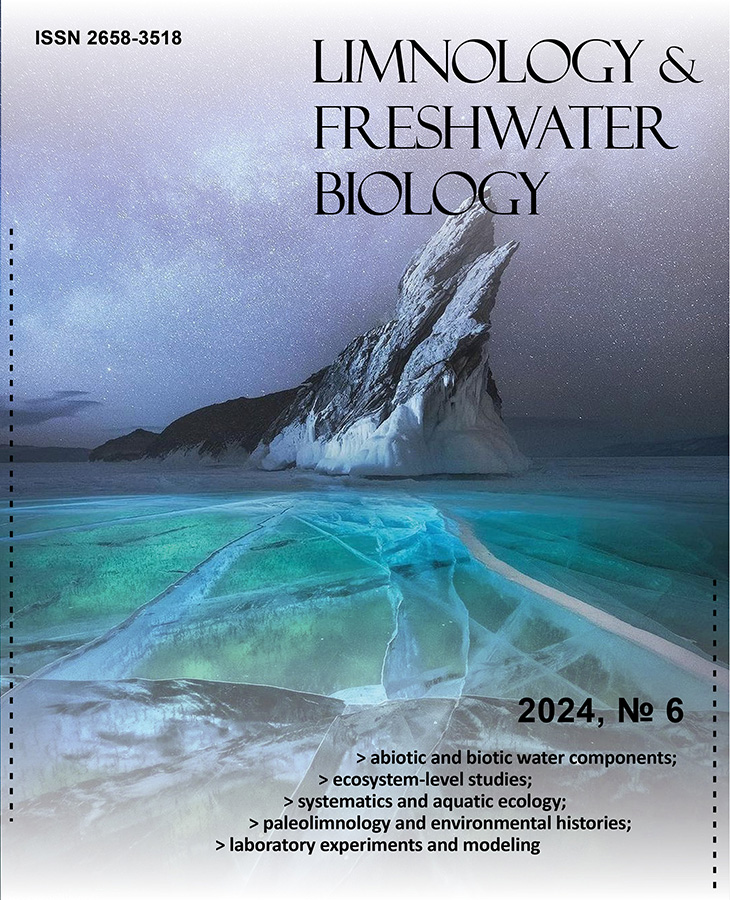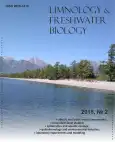Phytoplankton assemblages of the Southern Baikal in 1990-1995 and 2016-2018
- Авторы: Vorobyeva S.S.1
-
Учреждения:
- Limnological Institute, Siberian Branch of the Russian Academy of Sciences
- Выпуск: № 2 (2018)
- Страницы: 141-143
- Раздел: Статьи
- URL: https://journal-vniispk.ru/2658-3518/article/view/284257
- DOI: https://doi.org/10.31951/2658-3518-2018-A-2-141
- ID: 284257
Цитировать
Полный текст
Аннотация
At present, the littoral zone of the Southern Baikal is under anthropogenic impact. The negative changes in underwater vegetation landscapes most dramatically appeared near the Listvyanka settlement. In this study, we compare phytoplankton assemblages from the surface layer (ca. 1.5 m depth) near the Listvyanka settlement collected during 1990-1995 and 2016-2018. We have compared phytoplankton data with solar irradiance and air temperatures. Phytoplankton community was represented by 70 taxa, where Bacillariophyta and Cryptophyta dominated the biomass. In 2016-2018, there were no significant differences in biomass or abnormal seasonal vegetation of the studied phytoplankton taxa compared to 1990-1995
Ключевые слова
Об авторах
S. Vorobyeva
Limnological Institute, Siberian Branch of the Russian Academy of Sciences
Автор, ответственный за переписку.
Email: lana@lin.irk.ru
Россия, Ulan-Batorskaya Str., 3, Irkutsk, 664033
Список литературы
- Belikov S.I., Feranchuk S.I., Butina T.V. et al. 2018. Mass disease and mortality of Baikal sponges. Limnology and Freshwater Biology 1: 36–42. doi: 10.31951/2658-3518-2018-A-1-36
- Belykh O.I., Bessudova A.Yu., Gladkikh A.S. et al. 2011. Guidelines for the determination of biomass of species of phytoplankton in pelagic zone in Lake Baikal. Irkutsk: Irkutsk University publisher. (In Russian)
- Bondarenko N.A., Belykh O.I., Golobokova L.P. et al. 2012. Stratified distribution of nutrients and extremophile biota within freshwater ice covering the surface of Lake Baikal. The Journal of Microbiology 50: 8–16. doi: 10.1007/s12275-012-1251-1
- Fröhlich C. 2006. Solar irradiance variability since 1978. Space Science Reviews 125: 53–65.
- Jewson D.H., Granin N.G., Zhdanov A.A. et al. 2008. Resting stages and ecology of the planktonic diatom Aulacoseira skvortzowii in Lake Baikal. Limnology and Oceanography 53: 1125–1136.
- Khanaev I.V., Kravtsova L.S., Maikova O.O. et al. 2018. Current state of the sponge fauna (Porifera: Lubomirskiidae) of Lake Baikal: Sponge disease and the problem of conservation of diversity. Journal of Great Lakes Research 44: 77–85. doi: 10.1016/j.jglr.2017.10.004
- Khodzher T.V., Domysheva V.M., Sorokovikova L.M. et al. 2017. Current chemical composition of Lake Baikal water. Inland Waters 7: 250–258. doi: 10.1080/20442041.2017.1329982
- Khodzher T.V., Domysheva V.M., Sorokovikova L.M. et al. 2018. Hydrochemical studies in Lake Baikal: history and nowadays. Limnology and Freshwater Biology 1: 2–9. doi: 10.31951/2658-3518-2018-A-1-2
- Makarova I.V., Pichkily L.O. 1970. To some aspects of how to measure phytoplankton biomass. Botanical Journal 10: 1488–1494. (In Russian).
- Round F.E., Crawford R.M., Mann D.G. 1990. The Diatoms. Biology and morphology of the genera. Cambrige: Cambrige University Press.
- Starmach K. Chrysophyceae und Haptophyceae. 1985. In: Pascher A. (Ed.) Subwasserflora von Mitteleuropa. Bd. 1 Jena: VEB Gustav Fischer Verlag. (In German)
- The diatoms of the USSR (fossil and recent). II (2). 1992. In: Glezer S.I., Makarova I.V., Moisseeva A.I., Nikolaev V.A. (Eds.). SPb: Nauka. (In Russian).
- Timoshkin O.A. 2018. Coastal zone of the world’s great lakes as a target field for interdisciplinary research and ecosystem monitoring: Lake Baikal (East Siberia). Limnology and Freshwater Biology 1: 81–97. doi: 10.31951/2658-3518-2018-A-1-81
- Timoshkin O.A., Moore M.V., Kulikova N.N. et al. 2018. Groundwater contamination by sewage causes benthic algal outbreaks in the littoral zone of Lake Baikal (East Siberia). Journal of Great Lakes Research 44: 230–244. doi: 10.1016/j.jglr.2018.01.008
- Viereck R., Puga L. C. 1999.The NOAA Mg I1 core-to-wing solar index: Construction of a 20-year time series of chromospheric variability from multiple satellites. Journal of Geophysical Research 104: 9995-10005.
Дополнительные файлы










